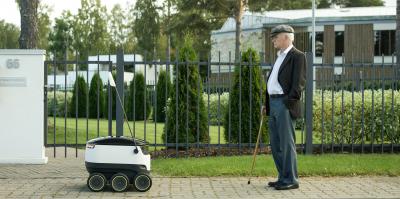Droids or Drones? Which Will Be the Future of Delivery?
Princess Leia bet on droids, not drones, to get her priority package delivered. And that turned out OK, except for her planet getting blown up. A Skype founder's new hope is that droids can work just as well on Earth.Bloomberg News, 19 April 2016 - In the shadow of Greenwich’s 02 Arena - the futuristic dome originally built as London’s showpiece for the Millennium - what looks like a picnic cooler on wheels zips among groups of gawking children. This little delivery robot, designed to autonomously navigate sidewalks, not roads, later this year will begin making deliveries from local businesses direct to customers.
In doing so, it may just conquer e-commerce’s final frontier: the Last Mile, the least efficient and most problematic step in the delivery process.Starship's robotic delivery droid is designed to detect and give way to pedestrians.“Thirty to forty percent of the cost of delivery comes in the last mile,” says Allan Martinson, the chief operating officer of Starship Technologies, the company building this robot. The venture is the brainchild of Ahti Heinla, one of Skype’s original developers, and is backed by billionaire Skype co-founder and tech investor Janus Friis.
The little delivery robots designed by Starship and a competing U.S. startup called Dispatch are the BB-8s and Wall-E's of e-commerce. These scrappy droids are up against tech's strongest forces. Amazon is testing airborne drones, as are Wal-Mart and Google. Google has also sought patents for a driverless truck that would carry an array of storage lockers that unlock with a text message. And Uber is deploying drivers for food delivery, a concept that could be expanded to other products. And don't forget incumbents from Federal Express and UPS to government postal services.
While Starship's robot may be first to market, victory isn't assured. The droids have limitations, with economic viability confined urban areas. Drones have a higher sticker price and bigger regulatory hurdles to surmount, but may prove less expensive on a per-mile basis. And for the foreseeable future, some logistics experts say, humans still have the edge over any sci-fi inspired contenders.
Heinla, a tall, gaunt Estonian with shaggy blond hair and the disheveled look of an engineer for whom form matters more than fashion, says delivery droids have their advantages. Smaller robots are easier and cheaper to build. Because Starship’s droid weighs less than 35 pounds and travels slowly, it's less likely to cause damage. As a wheeled vehicle, there are no spinning rotorblades that could cause injury - unlike drones. Continue to full article . . .

